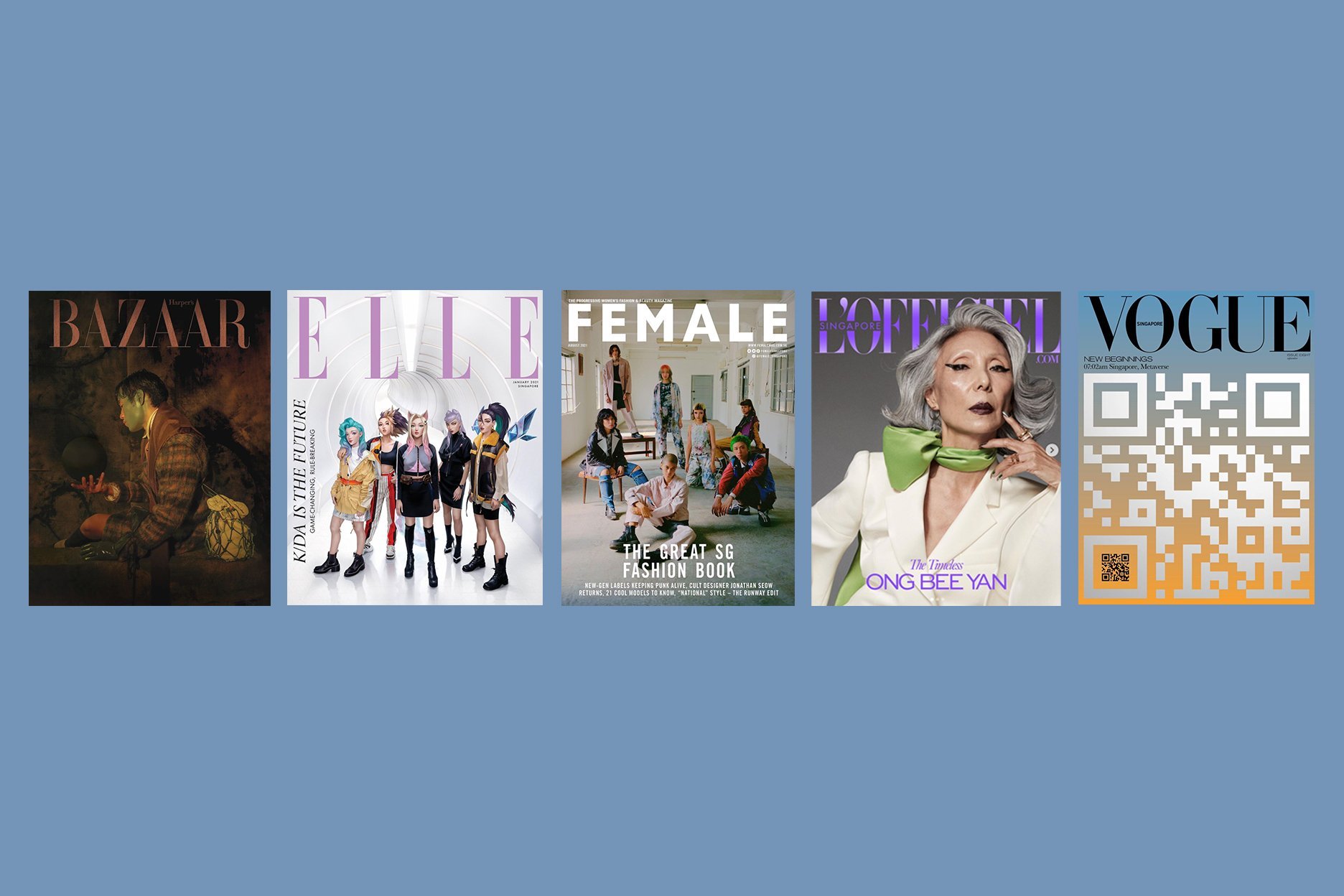Adoptions of The Aesthetic of Use in Southeast Asia
Ican Harem, Randolf Clothing, Vintage Wknd and more
By Daniela Monasterios-Tan
Image courtesy of Randolf Clothing.
The “aesthetic of use” refer to visual and structural elements that simulate or recall the effects and imperfections of wear and tear found on garments over time with extensive use . A variety of techniques and finishings such as mending, upcycling, raw and distressed finishings, deconstruction and patchwork are adopted to simulate the weathering of garments. This aesthetic has often been appropriated by counter and sub-cultural groups such as the hippies and punks who wore distressed and second-hand clothing as a rebellion to respectability and social hegemony. Beginning in the 1980s, avant-garde designers Rei Kawakubo and Martin Margiela were known to adopt the aesthetic of use to explore the passage of time, challenging the pristineness of fashion. The return of this aesthetic in recent years aligns with the move towards sustainable fashion more than with conceptual motives, and young designers have been embracing the patina of use.
Upcycling practices have been integrated into the business models of young designers such as Christopher Raeburn, Duran Lantink and Marine Serre in major fashion capitals in the past decade. Each designer is driven by historical and cultural philosophies of making do. For example, Emily Adams of New York-based BODE utilises quilting patchwork patterns that trace their roots to the 19th-century American Midwest. The possibility of tapping into more unconventional techniques is best exemplified by young, independent brands across Southeast Asia. These rising trends were also highlighted in the first survey of sustainable fashion in our region, published during Fashion Revolution Week 2021. While there are numerous designers and brands upcycling and repurposing waste across the region, our picks narrate the story of eclectic and dynamic designers across the market segments; from the luxurious upcycling of Carl Jan Cruz in the Philippines to single-designer operations such as artist Ican Harem from Indonesia.
INDONESIA: MUSIC, FASHION AND DIY
In the past decade, Indonesia’s fashion industry has increasingly seen government interventions to halt environmentally polluting practices. A proliferation of eco-friendly brands reflects the increased public awareness of sustainable fashion. Concerned with both the environmental and social aspects of sustainable fashion, brands have found ways to empower garment workers, revitalise traditional crafts and support marginalised groups. What is also interesting to note is not just Indonesia’s rich heritage of textile craftsmanship, but the strong underground music and fashion scene in cities like Yogyakarta, Jakarta and Bali. Upcycling in these communities can be seen as both a creative and a political act.
Ican Harem
Upcycled fashion by Ican Harem and Pinky Gurl Bali. Image taken from @icanharem Instagram.
Ican Harem is a multi-disciplinary artist best known as the MC for underground electronic collective Gabber Modus Operandi, known for remixing a mix of experimental sounds including Indonesian gamelan scales with heavy metal and Euro-club sounds. The garments he produces are bold remixes of batik, tourist souvenirs and band t-shirts which are upcycled and painted on. In 2019, his capsule collection, made of one-off pieces, was sold to critical acclaim at multi-label store Superfreak Boutique in Singapore.
Ctrl+N
Founded in 2018, CTRL+N utilises mending techniques like sashiko stitching and focuses on upcycling utility wear and denim jeans. Taking its name from the keyboard short-cut speaks of its digital nativity, harnessing the use of different social media platforms to spread their message and widen their customer base.
MALAYSIA: UPCYCLING TURNS DIGITAL
Malaysia’s manufacturing prowess results in a large amount of textile waste. There are various initiatives at the legislative level and non-profit organisations that are tackling waste, labour and increasingly advocate for the promotion of traditional crafts such as songket weaving. Government and corporate agencies are focused on supporting and training manufacturers to achieve their Sustainable Development Goals such as Malaysia’s External Trade Development Corporation (MATRADE), which initiated the Sustainability Action Values for Exporters (SAVE) campaign. On a smaller scale, upcycling allows young designers to use the rich resources of second-hand clothing and textile waste to create garments, cutting down on material costs. The key, as these labels show, is to find a niche aesthetic as there is no point competing with fast fashion labels and their economies of scale.
Ghostboy Club
Upcycled tee by Ghostboy. Image taken from @ghostboy.club Instagram.
Ghost.Boy Club is a niche, digitally-native label that references clothing style in the Y2K aesthetic. The brand has a cult following of young, tech-savvy Southeast Asian youths who find themselves drawn to the qipao-inspired silhouettes and pop culture references in the brand’s communications.
Ugly Pretty
Fashion designer Daren Yeap upcycles vintage clothing and accessories and sells his creations online. His upcycling practice began as a hobby, and he was encouraged by the reception of his clothing on Instagram and launched his brand Ugly Pretty in 2020. The brand has a niche following, but stylists have begun to loan his pieces to feature in music videos and photoshoots.
PHILIPPINES: DECENTERING FASHION
The Philippines was Southeast Asia’s textile-producing pioneer before the 1990s, and continues to count garment exports as one of its key industries. What has been interesting is the increased adoption of indigenous design wisdom and sustainable material production in the past decade. While manufacturing and textile production are an important part of the economy, the Philippines has also become the depository of a large and oftentimes illegal amount of second-hand clothing since the 1980s. For young designers interested in sustainability and zero-waste practices, upcycling is a natural approach to design.
Randolf Clothing
Image courtesy of Randolf Clothing.
Based in Manila, RJ Santos founded Randolf Clothing upon graduating in 2013. As Santos expresses, upcycling requires designers to challenge themselves technically and creatively as it can be simpler to cut a garment from scratch than to work off scraps and ready-made garments. “I just hate throwing things that can still be used and somehow I was able to apply it to my work for Randolf,” says Santos. “It is extra work because it takes more effort to be able to upcycle fabrics. There is extra attention to detail involved because you are not working with new uncut fabrics.”
TOQA
An experimental collaborative brand, TOQA’s work thrives off the limitations of working with what is available. Their multi-disciplinary and community-driven approach is best exemplified by Moody Isle 2020, where they worked with eco-resort El Nido Resorts, creating garments inspired by their surroundings and also employing staff and residents to model in their fashion film. They have also created a signature upcycled basahan tela (patchworked fabric) which they exhibited in a project with WWF Philippines.
SINGAPORE: MENDING IN A CITY OF NEW
Even though garment manufacturing is no longer a key industry in Singapore, fashion consumption is at the highest in the region. Since the 2000s, the fashion industry has been dominated by fast fashion chains and e-commerce, and continues to be a key market for luxury goods. Local fashion designers with small order quantities rely either on local cottage industries or regional manufacturing. Without local textile mills, designers rely on leftover stock-lot or overseas manufacturers who provide fabrics as a packaged deal.
Upcycling and mending seem almost counterintuitive in a city that places a high value on the newest and most efficient design solutions. While the fashion industry is investing in technology and textile innovation, upcycling is a manually intensive process that is slow and cannot be automated. The rise of second-hand and wardrobe-rental businesses in Singapore can attest to consumers’ increased awareness and desire for sustainable fashion. The opportunity to upcycle is a niche that is growing in visibility as Singaporeans begin to think about sustainability. Two collectives in particular show the potential of upcycling as a business and the importance of leveraging social media as a direct community-building tool.
FIN Crafted Goods
Mended Visvim shirt by FIN Crafted Goods. Image taken from @fincraftedgoods Instagram.
Inspired by the Japanese philosophy of mottainai, or a desire to avoid waste, FIN Crafted Goods creates workwear for brands, and mends and upcycles garments out of their studio based in Singapore. Utilising time-consuming and careful techniques such as sashiko, the brand tries to share the message with consumers in Singapore that new is not always better.
Vintage Wknd
Finding a sweet spot between upcycling and commercial viability, Vintage Wknd leverages e-commerce to reach a wide audience of youths. Launched in 2015, the brand sources second-hand clothing and textiles from around Asia and Europe. Their commercial success can be attributed to internet-friendly re-styling and the way they rework pieces to suit current trends. Unlike most upcycling brands, they do not sell out of their studio but through social media channels. They also choose their pop-up locations carefully to be as close to their demographic as possible, for example at youth-centric locations such as Bugis Junction.
The criticism of upcycling and recycling is that it is not the answer to widespread change in the fashion industry. Yet, as a transitional strategy, it points to increasingly socially aware designers and consumers in Southeast Asia. The rise of upcycling also highlights possible avenues for independent designers to find unique ways to continue to create without having to rely on textile manufacturing, and to take advantage of technology to aid in distribution and communication.















